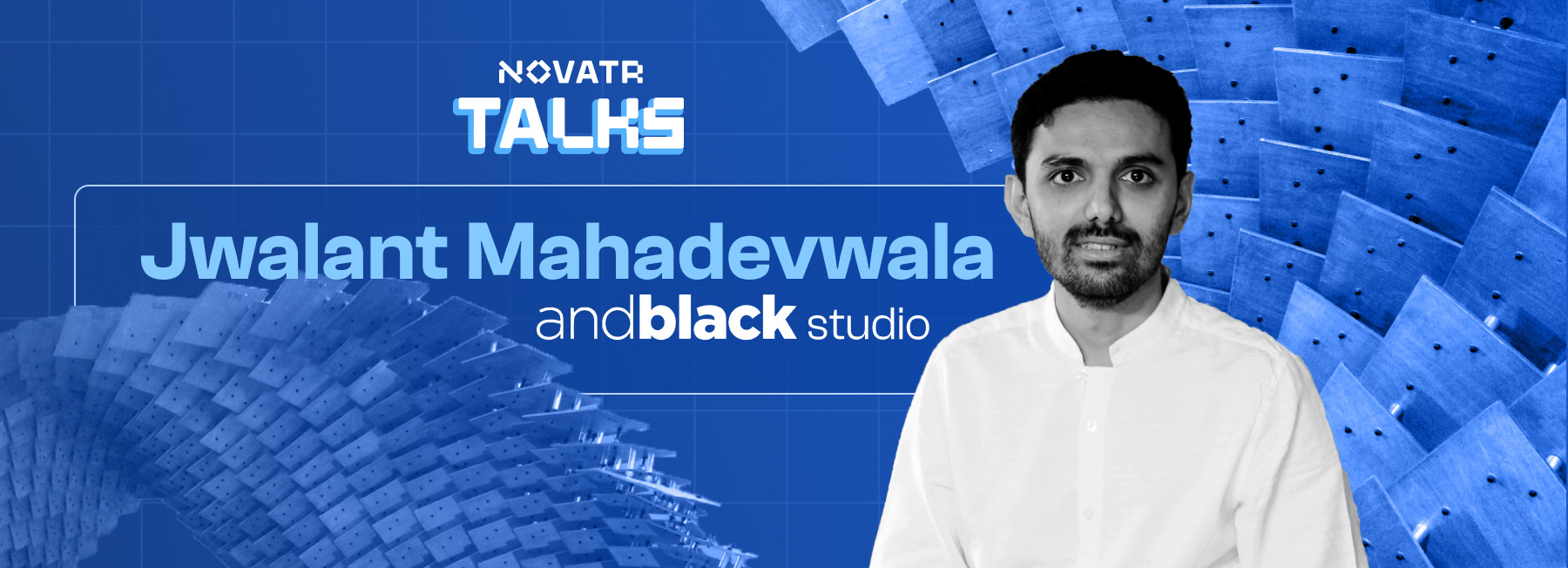Conventional Projects using Computational Design: Studio Founder Jwalant Mahadevwala

Table of Contents
What do you think when you imagine a building constructed using parametric or Computational Design? It’s a simple question that usually results in a few common answers. You may first think of fluid designs in structures like Frank Gehry’s iconic Guggenheim Museum in Bilbao. Or maybe you think of modern responsive facades like those designed by Aedas Architects for Al Bahar Towers. Perhaps you go a bit old school and think of designs and structures like Karl Schwanzer’s work for Bayerische Motoren Werke AG (BMW) Welt or Antoni Gaudi’s work for the Basilica Sagrada Familia.
No matter which structure or architect you immediately think of, you are not going to think of just any old conventional architectural design. But andblack design studio founder and principal designer, Jwalant Mahadevwala, says that’s exactly the kind of thinking that needs to be corrected in an interview with our Computational Design Course Director Kanwaljeet Singh.
What does he mean? Let’s take a look.
Jwalant Mahadevwala - A Quick Intro
Jwalant Mahadevwala is the founding partner and principal architect at andblack design studio. Jwalant has pursued a master's in Architecture and Urbanism at the Architectural Association School of Architecture, London in the Design Research Laboratory. He furthered his professional experience at Zaha Hadid Architects in London for the next four years. Jwalant, along with his partner Kanika Agarwal, started andblack design studio in 2012 in Ahmedabad. andblack is an interdisciplinary award-winning design studio which works in the field of architecture, interiors, furniture design and art installation. Jwalant’s research at AA and his work at andblack have been globally recognised and widely published in National and International publications.
Let’s now cover his journey into architecture.
His foray into architecture began at a very young age, with his father having his architecture practice.
“I used to go to sites with him. At that time, it was a lot more about making things. That world was very different because you didn't have any computers. This hands-on experience led me to have an interest in making things,” said Jwalant.
Jwalant would carry his interest in architecture and making things through his work and education. But where does parametric architecture come into Jwalant’s life? Through his passion for making things, he answered.



Project : Darwin Bucky by andBlack studio
Photo credits : ©Edmund Sumner
Enter Parametricism
“Even during education, my interest was always in making things. I was interested in learning how to make a model and what to use to make a model, rather than just looking at a model only to represent architecture. Then that turned to how the model can inform architecture. Then that led me into parametric design.”
“I had no clue for a long time what it meant. Yeah, in the early 2000s nobody knew what it meant,” he added.
But the transition from working with computational tools in one of the bustling cities of architectural practice in one of the world’s biggest firms, to coming back to India and using the same techniques wasn’t an easy jump.
| “I had to very quickly move away from just looking at anything digitally to thinking about how to make it happen.”|
“When I came back to India, I had this beautiful notion that whatever you make on a computer can be made in real life as well. And the moment I started my practice in India, I realised that this was not the truth. When you are out there in a developed nation, you design what you want and there are people all around you who will make it possible,” he admitted. The transition meant that Jwalant quickly learnt that anything made digitally needed to have a serious consideration of how to translate that into making that possible."
Computational but Conventional
This digital realism is why Jwalant believes that Computational Design isn’t a separate form of architecture from conventional architecture. Instead, he thinks that computational is all about adding in layers of complexity. And what is architecture if not celebrating all the complexities of design?
“There was a time when parametric architecture was introduced as a term. But before that, Frieh Otto had been doing it. Gaudi did it in a different way as well. People have been exploring complex geometries and interactions. But because of modernism, everything ended up becoming minimal, which is why I also like that form of architecture.”
“The moment we want to add complexity into the design, these kinds of thought processes help you add those layers into your design thinking. But it need not look like a computational building. And people actually have an image of computational forms which is also completely, completely wrong,” he adds with a grin.
Taking his own example, Jwalant admits that while he likes fluid or faceted forms that doesn’t mean that everything that he designs will look anything like that. “Whatever line I draw as a computational line doesn't need to be fluid, doesn't need to be faceted, or doesn't even need to be complex looking. You can have a very simple floor plan and you can create over 100 iterations using computational tools, but it can still look like a conventional building,” Jwalant explains.
| Making a temple – it's a very, very complex process. Can that be computational? Absolutely.|



Project : Wooden Lattice by andblack Studio
Photo credits : andblack Studio
Taking an example of one of the most conventional architectural structures, a temple, Jwalant says even that is possible through computational design. “Making a temple – it's a very, very complex process. Can that be computational? Absolutely. Because they are all based on geometrical principles of dividing a certain square, adding certain squares, and then further detailing those squares.”
Though architectural firms like Zaha Hadid have made parametricism and Computational Design with a certain style, many more firms are already using computational workflows. They, however, use Computational Design to solve design problems for sustainability or carbon emissions. But these buildings can look like just “regular” structures.
The End-to-End View
Despite being extremely talented at computational tools, Jwalant doesn’t think of himself as just a computational designer. Instead, he prefers to take a more zoomed approach to his work. In 12 years of work, andblack design studios have taken on multiple scales and kinds of work from architectural design, art installations, and even furniture. The one common thread is constantly creating something, not just in terms of digital modelling but also conceptualisation.
“It's beyond just how it looks. It goes into a range of thought processes of conceptualisation to making which makes me a carpenter, a fabricator, and whatever I need to become along with my craftsmen.”
Computational Design in and black design studio
andblack’s team comprises around 25 architects, designers, and interns. Under Jwalant’s leadership, andblack’s practice is a blend of traditional and computational approaches, emphasising versatility in architectural methodologies. Only 2 to 3 team members are dedicated computational designers specialising in tools like Grasshopper and Rhino. This balance ensures the studio can tackle a wide range of projects while maintaining a robust computational edge.
How Computational Design Fits in the andblack Studio Picture
At andblack design studio, Computational Design is integrated to enhance both the efficiency and creativity of the architectural process. The studio employs computational tools not just for speeding up repetitive tasks but for enabling rapid iteration and informed decision-making. For instance, parametric models allow for quick adjustments and evaluations of structural grids, significantly reducing manual effort and enabling more dynamic and innovative designs.
How to Master Computational Design in India?
1. Becoming an Exceptional Computational Designer
Mastering Computational Design involves a combination of formal education and practical experience. While advanced degrees can provide foundational knowledge and credibility, self-taught individuals with a strong portfolio can also excel. Essential skills include proficiency in tools like Grasshopper, Rhino, and Python, along with a solid understanding of architectural principles and problem-solving abilities.
2. Basic Skills and Requirements Looked At
When hiring computational designers, andblack looks for individuals who can independently develop scripts from scratch, demonstrating both creativity and technical prowess. Quick learning ability and practical problem-solving skills are crucial, as real-life projects often present unique challenges that go beyond theoretical knowledge.
3. Masters vs. Self-Taught/Upskilled
Both formally educated and self-taught designers are valued, provided they can show a high degree of competence and initiative. While a master's degree can offer structured learning and exposure to advanced concepts, self-taught designers who continually upskill through online courses and practical projects can also be highly competitive.
Project Spectrum for Computational Designers
1. Generative Architecture and Parametric Architecture
Computational design at andblack often involves generative and parametric approaches, allowing for the creation of complex, adaptive structures. These methods enable designers to explore multiple design iterations quickly, refining concepts based on various performance criteria such as structural integrity, spatial efficiency, and aesthetics.
2. Modern Architecture
Incorporating Computational Design into modern architecture at andblack allows for innovative solutions that respond dynamically to environmental and functional requirements. This approach leads to more sustainable and efficient buildings that push the boundaries of traditional architectural practices.
3. Future of Parametric Design in India
The future of parametric design in India is promising, with increasing recognition of its potential to revolutionise architectural practices. As more firms adopt these technologies, there will be a growing demand for skilled computational designers who can leverage parametric tools to create cutting-edge designs that are both functional and aesthetically compelling.
Conclusion
Jwalant Mahadevwala, the visionary behind andblack design studio, is redefining architecture with computational design. His philosophy transcends efficiency, using advanced tools to drive creativity and informed decision-making. At andblack, a balanced integration of computational methods and traditional practices ensures innovative and versatile solutions.
Jwalant champions quick learning and problem-solving, seeking team members who can independently craft scripts and tackle real-world challenges. This ethos fosters a studio where both formally educated and self-taught designers thrive, united by their technical prowess and creative vision.
Looking ahead, Jwalant sees immense potential for parametric and generative design in India, predicting a surge in demand for skilled computational designers. Under his leadership, andblack is poised at the forefront of this architectural evolution, blending cutting-edge technology with timeless design principles.
If you wish to be one of this league, you must explore the Computational Design Course offered by Novatr The course offers you the opportunity to learn in-depth about computational design processes, tools, and workflows.

 Thanks for connecting!
Thanks for connecting!

.png)

.png)

.jpg)

